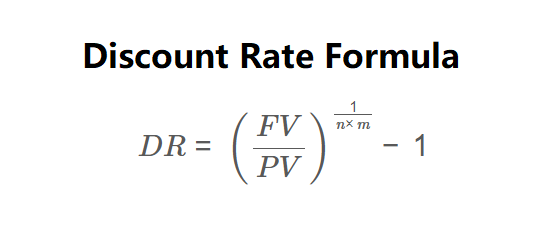1. What is the Discount Rate Calculator?
Definition: This calculator computes the discount rate (\( DR \)) that equates the Present Value (\( PV \)) of an investment to its Future Value (\( FV \)) over a specified number of periods (\( n \)) with a given compounding frequency (\( m \)).
Purpose: Investors and financial analysts use this tool to determine the rate of return or discount rate needed to achieve a specific future value from a present investment, aiding in financial planning and investment analysis.
2. How Does the Calculator Work?
The calculator uses the following formula, as shown in the image above:
\[ DR = \left( \frac{FV}{PV} \right)^{\frac{1}{n \times m}} - 1 \]
Where:
- \( PV \): Present Value (in selected currency);
- \( FV \): Future Value (in selected currency);
- \( n \): Number of Periods (in years);
- \( m \): Compounding frequency per year;
- \( DR \): Discount Rate per compounding period (converted to an annual percentage).
Steps:
- Enter the Present Value (\( PV \)) and select the currency (USD, EUR, GBP, JPY).
- Enter the Future Value (\( FV \)) in the same currency.
- Enter the Number of Periods (\( n \)) in years.
- Select the Compounding Frequency (\( m \)) from the options: Annually (1), Quarterly (4), Monthly (12), or Daily (365).
- The calculator computes the discount rate per compounding period using the formula above, converts it to an annual rate (\( DR \times m \times 100 \)), and displays it as a percentage.
- The result is formatted (scientific notation for values < 0.001, otherwise 4 decimal places) and displayed as a percentage per year.
3. Importance of Discount Rate Calculation
Calculating the discount rate is essential for:
- Investment Analysis: Determines the rate of return needed to justify an investment based on its present and future values.
- Valuation: Used in financial models to discount future cash flows to their present value, aiding in project or business valuation.
- Decision Making: Helps compare investment opportunities by providing a standardized rate of return metric.
4. Using the Calculator
Example 1: Calculate the discount rate for an investment with a Present Value of $10,000, a Future Value of $12,763, a term of 5 years, and annual compounding, in USD:
- Present Value (\( PV \)): $10,000;
- Future Value (\( FV \)): $12,763;
- Number of Periods (\( n \)): 5 years;
- Compounding Frequency (\( m \)): Annually = 1;
- Discount Rate (\( DR \)): \( \left( \frac{12,763}{10,000} \right)^{\frac{1}{5 \times 1}} - 1 = (1.2763)^{\frac{1}{5}} - 1 = 1.05 - 1 = 0.05 \), Annual Rate = \( 0.05 \times 1 \times 100 = 5.0000\%/year \).
Example 2: Calculate the discount rate for an investment with a Present Value of €15,000, a Future Value of €16,386.24, a term of 2 years, and quarterly compounding, in EUR:
- Present Value (\( PV \)): €15,000;
- Future Value (\( FV \)): €16,386.24;
- Number of Periods (\( n \)): 2 years;
- Compounding Frequency (\( m \)): Quarterly = 4;
- Discount Rate (\( DR \)): \( \left( \frac{16,386.24}{15,000} \right)^{\frac{1}{2 \times 4}} - 1 = (1.092416)^{\frac{1}{8}} - 1 \approx 0.01109 \), Annual Rate = \( 0.01109 \times 4 \times 100 = 4.4360\%/year \).
5. Frequently Asked Questions (FAQ)
Q: Why does compounding frequency affect the calculated rate?
A: The frequency of compounding changes the effective rate. More frequent compounding results in a slightly lower annual rate to achieve the same future value.
Q: Can the discount rate be negative?
A: Yes, if the Future Value is less than the Present Value, the discount rate will be negative, indicating a loss over the term.
Q: What if the Future Value equals the Present Value?
A: If \( FV = PV \), the discount rate will be 0%, indicating no growth or loss over the term.
Discount Rate Calculator© - All Rights Reserved 2025
 Home
Home
 Back
Back
